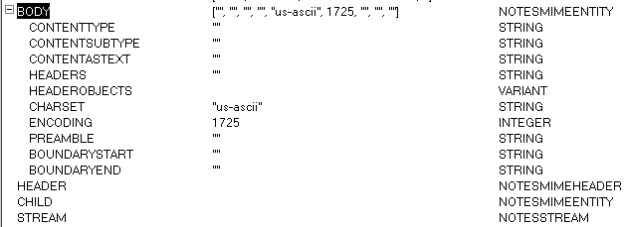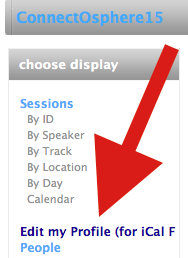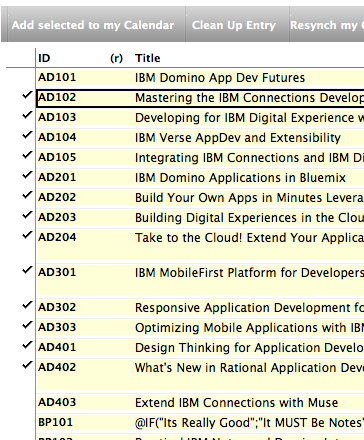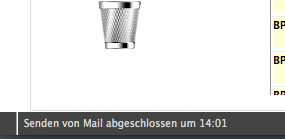After an Upgrade from Domino 9.0.1 FP4 to FP5 on Windows Server, our Domino server crashed frequently. It left no reason in the logs, just simply started from scratch and left an NSD File. We sent a PMR to IBM and finally found out, the crash could be reproduced with one certain agent.
After debugging a while, I found the reason, and, more important for me, I learned something about the Lotusscript NotesMIMEEntity Class.
What we want to do
Sometimes, as a company, you want to send mails from a user friendly looking account, like “We love our Customers<noreply@company.com>”Trust model 😉. Good idea. The issue is, that the Domino Server tends to send that mail with the sender name of the Notes-ID that signed the Agent code in a Field “Sent by:”. That’s also not exactly, what you want the recipients to see.
So, the existing idea was, for some time already, to choose a little workaround within Domino. Put the mail in “Mail.box” on your server, make up a MIME mail yourself by writing the MIME parts in your own code (not depending on the Server conversion) and then simply SAVE the document in mail.box, not SEND it. The router will take it from there, take your Sender address (which was made up with code) for given and send it to your customer. The method is described by Josef Hoetzl here, thank you.
CAVEAT: Before you take the following agent as your example, be aware, there’s code that crashes the server. The (for today) reliable version is at the end of this post.
So, here is a simple (but dangerous) agent:
Sub Initialize On Error GoTo Errorhandler Dim s As New NotesSession Dim dbmailbox As NotesDatabase Dim maildoc As NotesDocument Dim body As NotesMIMEEntity Dim header As NotesMIMEHeader Dim child As NotesMIMEEntity Dim stream As NotesStream Dim sender As String Dim send2Address As String sender = "Yellowbleeders<notes@ibmlotus.com>" send2Address = "Kermit_the_frog@theMuppets.com" Set dbmailbox = s.getDatabase(s.currentdatabase.server,"mail.box",False) 'opens the server's mailbox 'Make the new document Set maildoc = New NotesDocument(dbmailbox)
Pretty easy until here, then we have to tell Domino, that we do all the MIME stuff ourselves.
s.Convertmime = False
That is a session property. We are supposed to reset it later. I’ve read other code for that property, like a switch/toggle version, but for simplicity, we stay here. Roland Praml has the ultimate Class here, thank you, Roland.
Now, on for the MIME part. Check Wikipedia for the different parts and specific order.
' Create the MIME Entity
Set body = maildoc.CreateMIMEEntity
'Create the MIME headers
Set header = body.CreateHeader({MIME-Version})
Call header.SetHeaderVal("1.0")
'Content Type
Set header = body.CreateHeader("Content-Type")
Call header.SetHeaderValAndParams({multipart/alternative;charset="UTF-8"})
'Subject
Set header = body.CreateHeader("Subject")
Call header.SetHeaderVal("Testmail")
'To
Set header = body.CreateHeader("To")
Call header.SetHeaderVal(send2Address)
'From (the lied adapted address)
Set header = body.CreateHeader("From")
Call header.SetHeaderVal(sender)
'Recipients (see RFC 2822)
'In RFC 2822 there is not "Recipients" header, but
'there is "other/optional" headers.
'We had it here because of a mistake
'This is the Killer for Fixpack 5! But the crash itself happens later
'(Yellow dressed Uma Thurman)
Set header = body.CreateHeader("Recipients")
Call header.SetHeaderVal(send2Address)
' *** Headers set, begin Mail Body ***
'Send the plain text part first
Set child = body.createChildEntity() 'ChildEntities within the MIMEEntity
Set stream = s.createStream()
Call WritePlainText(stream) ' see later, content is made outside in a sub
Call child.setContentFromText(stream, {text/plain;charset="iso-8859-1"}, ENC_IDENTITY_8BIT)
Call stream.Truncate() ' ends the first child
'Send the HTML part.
Set child = body.createChildEntity()
Call WriteHTML(stream) ' same as with plain text, content is maintained outside
Call child.setContentFromText(stream, {text/html;charset="iso-8859-1"},ENC_IDENTITY_8BIT)
Call stream.Truncate()
'Close the stream
Call stream.Close()
'Close the whole MIME Part
Call maildoc.Closemimeentities(True) ' <--------------------- BOOOOOM! Tarantino.
' it turns out, that CloseMimeEntities does not like a header with the name
' Recipients. You can add other names, but not Recipients. Recipients just lets
' your server die.
Now there is some Notes Fields. They are for the Domino Router task. It needs some information in fields, it seems.
I messed around with assigning the fields in the first part of the code, before I did the MIME stuff. But it turns out, that Domino, when you create some fields with keywords BEFORE you create the MIMEEntity, it automatically converts your field contents to MIME headers, hence ignoring your s.ConvertMIME = False. What happens next, if you create that header “again” in your code, your header pointer will be nothing and then, when you want to set it’s value, you get “Object variable not set”.
So if your code says:
Call maildoc.replaceItemvalue("Form", "Memo")
Call maildoc.replaceItemvalue("Subject", "NotesSubjectTest")
BEFORE you set
Set header = body.CreateHeader("Subject")
Call header.SetHeaderVal("Testmail")
then with Call header.SetHeaderVal(“Testmail”), it bails out.
The internal structure of the MIME Object looks like this, immediately after creating the mime entity from the example:

so, after setting some headers, the following happens:

1a shows a name for a list. The name is “HEADERS”. You can see in
1b, that list is a collection of Headerobject names, followed by a colon, and the content as string. If you look at
1c, you see the “Subject”-line with it’s content. Apparently, as seen in
1d, the list is separated with linefeeds, the height of that line is one line exactly, but you can use the arrows to go up and down.
Oh, and the Headerobjects (not open in that picture) contain the Name as String.
What happens, if you set your Notes fields before you begin your MIME? Some implicit fun.

CreateMIMEEntity also looks at the underlying Notes Document and finds a few fields it takes as headers for MIME. It may be a philosophical question, if we want it to do that, given that we explicitly switched off MIME Conversion. But, nevertheless, this is what happens:
a) an existing Subject field is going to the MIME header “Subject”
b) an existing From field goes to a “From” header
c) BUT!!! an existing SendTo field is converted to a “To” header. BUT2: I tried it: if you make a “To” field, it DOES NOT convert into the “to” header. Don’t ask me, why. I could interpret a line in the help document about getting special support if you name your mime entity “body” (Just a wild guess: Home office here?) Did not try with more keywords, though.
(UPDATE3: Tested with a different name for the MIMEEntitiy, instead of “body” I took “myMIME”. The sequence of inheritance is exactly the same as described. There is no difference in handling depending on the name of the entity. My interpretation of documentation was wrong for this line :ENDOFUPDATE3)
The PROBLEM then is: If you create a header with body.CreateHeader(“Subject”) after that, the header will neither point to the existing header nor to a newly created header. It is NULL. When assigning a value with Call header.SetHeaderVal, you get “Object variable not set”.
The workaround: If you are aware of the issue, you could use Call header.AddValText(“This is my Umlaut Test äöüß”,”iso-8859-1″), where the second parameter is the iso character set. See Josef Hoetzl again for filename save character sets.
Safety would suggest, you used, if you are not sure you are alone, some code to test for existing headers. Just an example from help. There is a documentation at IBM: IBM Knowledge Center
Forall header In body.HeaderObjects
' some test code
End Forall
UPDATE: The Fixpack 5 issue was recognized as a SPR and APAR and should be solved in the future.
Update 2: the easy working agent, as promised.
Update 3: Sven Petri pointed to an issue in his comment, I added the line needed below.
%REM
Agent RFC2822 safe version for Domino901FP5 and up-
Created Feb 15, 2016 by haha/saidtheclown
Description:
The agent creates a new document in mail.box of the current server.
it then creates a MimeEntity and sets some Headers, some content and stores the document,
but does not SEND it.
Thus, the Router picks up the doc and sends it with the sender we put in the FROM Header, not using
the signer of the agent, which would use if we SENT it.
%END REM
Option Public
Option Declare
Sub Initialize
On Error GoTo Errorhandler
Dim s As New NotesSession
Dim dbmailbox As NotesDatabase
Dim maildoc As NotesDocument
Dim body As NotesMIMEEntity
Dim header As NotesMIMEHeader
Dim child As NotesMIMEEntity
Dim stream As NotesStream
Dim sender As String
Dim send2Address As String
s.Convertmime = False
sender = "Yellowbleeders<notes@ibmlotus.com>"
send2Address = "kermit_the_frog@themuppets.com"
Set dbmailbox = s.getDatabase(s.currentdatabase.server,"mail.box",False)
'Make the new document
Set maildoc = New NotesDocument(dbmailbox)
' Create the MIME Entity
Set body = maildoc.CreateMIMEEntity
'Create the MIME headers
Set header = body.CreateHeader({MIME-Version})
Call header.SetHeaderVal("1.0")
'Content Type
Set header = body.CreateHeader("Content-Type")
Call header.SetHeaderValAndParams({multipart/alternative;charset="UTF-8"})
'Subject
Set header = body.CreateHeader("Subject")
Call header.SetHeaderVal("Testmail")
'To
Set header = body.CreateHeader("To")
Call header.SetHeaderVal(send2Address)
'From
Set header = body.CreateHeader("From")
Call header.SetHeaderVal(sender)
'SendTo
Set header = body.CreateHeader("SendTo") ' not really needed, but allowed
Call header.SetHeaderVal(send2Address)
' *** Headers set, begin Mail Body ***
'Send the plain text part first
Set child = body.createChildEntity() 'ChildEntities are containers
Set stream = s.createStream()
Call WritePlainText(stream)
Call child.setContentFromText(stream, {text/plain;charset="iso-8859-1"}, ENC_IDENTITY_8BIT)
'Send the HTML part.
Call stream.Truncate()
Set child = body.createChildEntity()
Call WriteHTML(stream)
Call child.setContentFromText(stream, {text/html;charset="iso-8859-1"},ENC_IDENTITY_8BIT)
'Close the stream and Send it
Call stream.Truncate()
Call stream.Close()
Call maildoc.Closemimeentities(True)
' Done with the MIME Stuff, now on to setting fields for Notes
Call maildoc.replaceItemvalue("Form", "Memo")
Call maildoc.replaceItemvalue("Subject", "NotesSubjectTest")
Call maildoc.replaceItemvalue("SendTo", send2Address)
Call maildoc.replaceItemvalue("From", sender)
Call maildoc.Replaceitemvalue("Recipients", send2Address) ' This is the Notes FIELD
'Update 3 20160711
Call maildoc.Replaceitemvalue("PostedDate",Now) ' see Sven Petri's reply
' End of Update 3
Call Maildoc.Save(True,False) 'just save, so spoofing works.
Exit Sub
ErrorHandler:
Print Erl, Error
End Sub
Sub WritePlainText(stream As NotesStream)
Dim Plain As String
Plain = "plain Content"
Call stream.WriteText(Plain , EOL_CRLF)
Done:
End Sub
Sub WriteHTML(stream As NotesStream)
Dim content As Variant
'BEGIN: Header
Call stream.WriteText(|<!DOCTYPE HTML PUBLIC "-//W3C//DTD HTML 4.01 Transitional//EN" "http://www.w3.org/TR/html4/loose.dtd">| & Chr(10) )
Call stream.WriteText(|<html>| & Chr(10))
Call stream.WriteText(|<head>| & Chr(10))
'END: HEADER
Call stream.WriteText (|</head>| & Chr(10) )
' BEGIN: HTML body
Call stream.WriteText (|<body>| & Chr(10) )
Call stream.WriteText (||)
'BEGIN: Content Call stream.Writetext("HTML Content", 0)
Call stream.WriteText (|| & Chr(10) )
Call stream.WriteText (|</body>| & Chr(10) )
' END: HTML bodydiv
'Close the HTML
Call stream.WriteText (|</html>| & Chr(10) )
End Sub







